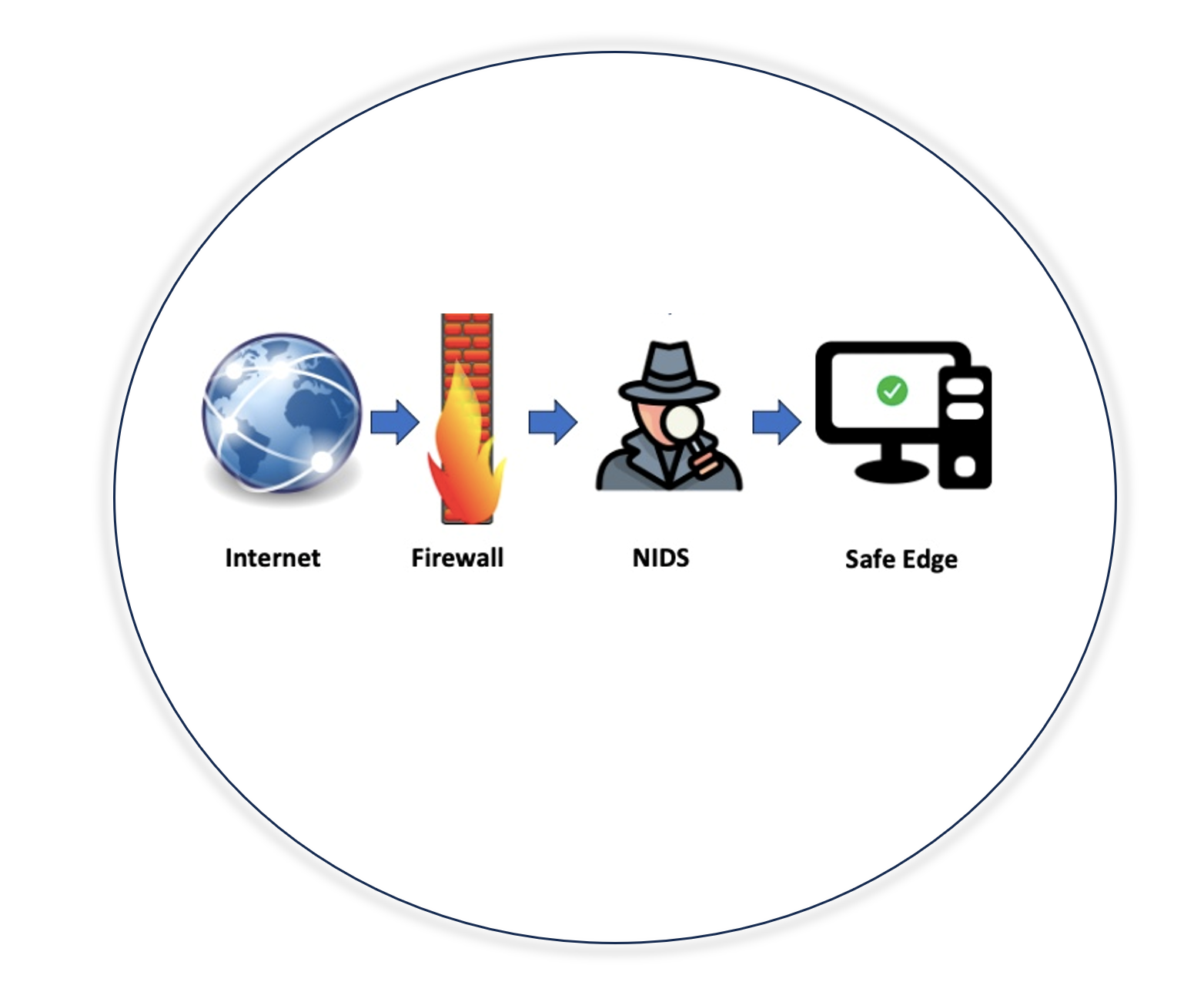A Hybrid Technique Based on RF-PCA and ANN for Detecting DDoS Attacks IoT
DOI:
https://doi.org/10.51173/ijds.v1i1.9Keywords:
Network Intrusion detection system (NIDS), ANN, IoT, DDoSAbstract
The increasing reliance on smart products has increased vulnerabilities in Internet of Things (IoT) traffic, which poses significant security risks. These vulnerabilities allowed some hackers to exploit them, which led to system performance degradation. Attacks can lead to these vulnerabilities to various undesirable outcomes, including data leakage, economic losses, data breaches, operational disruptions, and damage to the company's reputation. To address these security challenges, network intrusion detection alarms play a crucial role in assessing system security. In recent years, the proliferation of intelligent and soft computing-based algorithmic and structural frameworks has been evident. However, previous studies have faced challenges related to comprehensiveness, zero-day attacks, realism, and data interpretation. In light of these concerns, this study proposes to design a neural network for proactive detection of attacks. Moreover, we propose to use a hybrid system called RF-PCA to facilitate dimensionality reduction and help classifiers. Notably, this is the first application of a BOT-IoT data set in such an approach. The study also includes a discussion of relevant IoT terms in the context of our work. The proposed method uses high-level data features to represent and draw conclusive conclusions. To evaluate its effectiveness, an experiment was conducted using Python as the programming environment, achieving a remarkable detection rate of 99.73%.
Downloads
References
A. Holst, “Number of Connected Devices Worldwide 2030; Statista,” Statista: Hamburg, Germany, 2018.
M. Wazzan, D. Algazzawi, O. Bamasaq, A. Albeshri, and L. Cheng, “Internet of things botnet detection approaches: Analysis and recommendations for future research,” Applied Sciences (Switzerland), vol. 11, no. 12. MDPI AG, Jun. 02, 2021. doi: 10.3390/app11125713.
M. A. Ferrag and L. Maglaras, "DeepCoin: A Novel Deep Learning and Blockchain-Based Energy Exchange Framework for Smart Grids," in IEEE Transactions on Engineering Management, vol. 67, no. 4, pp. 1285-1297, Nov. 2020, doi: 10.1109/TEM.2019.2922936.
A. Yaseen Abdulrazzak, S. Latif Mohammed, A. Al-Naji, and J. Chahl, “Computer-Aid System for Automated Jaundice Detection,” Journal of Techniques, vol. 5, no. 1, pp. 8–15, Mar. 2023, doi: 10.51173/jt.v5i1.1128.
Asaad Yaseen Ghareeb, S. K. Gharghan, A. H. M. Mutlag, and Rosdiadee Nordin, “Wireless Sensor Network-Based Artificial Intelligent Irrigation System: Challenges and Limitations,” Journal of Techniques, vol. 5, no. 3, pp. 26–41, Aug. 2023, doi: 10.51173/jt.v5i3.1420.
P. Manso, J. Moura, and C. Serrão, “SDN-based intrusion detection system for early detection and mitigation of DDoS attacks,” Information (Switzerland), vol. 10, no. 3, 2019, doi: 10.3390/info10030106.
M. A. Ferrag, L. Maglaras, A. Ahmim, M. Derdour, and H. Janicke, “RDTIDS: Rules and decision tree-based intrusion detection system for internet-of-things networks,” Future Internet, vol. 12, no. 3, Mar. 2020, doi: 10.3390/fi12030044.
M. Aamir and S. M. A. Zaidi, “DDoS attack detection with feature engineering and machine learning: the framework and performance evaluation,” Int J Inf Secur, vol. 18, no. 6, pp. 761–785, Dec. 2019, doi: 10.1007/s10207-019-00434-1.
R. Biswas and S. Roy, “Botnet traffic identification using neural networks,” Multimed Tools Appl, vol. 80, no. 16, pp. 24147–24171, Jul. 2021, doi: 10.1007/s11042-021-10765-8.
V. Hassija, V. Chamola, V. Saxena, D. Jain, P. Goyal, and B. Sikdar, “A Survey on IoT Security: Application Areas, Security Threats, and Solution Architectures,” IEEE Access, vol. 7. Institute of Electrical and Electronics Engineers Inc., pp. 82721–82743, 2019. doi: 10.1109/ACCESS.2019.2924045.
M. M. , T. M. A. , & E.-S. A. B. Sakr, “An efficiency optimization for network intrusion detection system. International Journal of Computer Network and Information Security,” vol. 11(10), no. 1, 2019, doi: 10.5815/ijcnis.2019.10.01.
M. A. Cheema, H. K. Qureshi, C. Chrysostomou, and M. Lestas, “Utilizing Blockchain for Distributed Machine Learning based Intrusion Detection in Internet of Things,” in Proceedings - 16th Annual International Conference on Distributed Computing in Sensor Systems, DCOSS 2020, Institute of Electrical and Electronics Engineers Inc., May 2020, pp. 429–435. doi: 10.1109/DCOSS49796.2020.00074.
B. Hajimirzaei and N. J. Navimipour, “Intrusion detection for cloud computing using neural networks and artificial bee colony optimization algorithm,” ICT Express, vol. 5, no. 1, pp. 56–59, Mar. 2019, doi: 10.1016/j.icte.2018.01.014.
C. , C. R. L. , S. J. , W. C. , A. M. , S. A. , & P. A. Dietz, “IoT-botnet detection and isolation by access routers,” in In 2018 9th International Conference on the Network of the Future (NOF) , 2018, pp. 88–95. doi: 10.1109/NOF.2018.8598138.
J. , S. K. M. K. C. D. S. and R. D. Vandarkuzhali, “Hybrid RF and PCA method: The number and Posture of piezoresistive sensors in a multifunctional technology for respiratory monitoring,” Sensors, vol. 29, no. 100832, 2023. doi: 10.1016/j.measen.2023.100832.
K. M. Z. F. H. and W. L. Bian, “RF-PCA: A new solution for rapid identification of breast cancer categorical data based on attribute selection and feature extraction,” Front Genet, vol. 11, no. 566057, 2020. doi: 10.3389/fgene.2020.566057.
R. Gopi et al., “Enhanced method of ANN based model for detection of DDoS attacks on multimedia internet of things,” Multimed Tools Appl, vol. 81, no. 19, pp. 26739–26757, Aug. 2022, doi: 10.1007/s11042-021-10640-6.
Peterson, J. M., Leevy, J. L., and Khoshgoftaar, “A review and analysis of the bot-iot dataset,” in In 2021 IEEE International Conference on Service-Oriented System Engineering (SOSE), IEEE, Aug. 2021, pp. 20–27. doi: 10.1109/SOSE52839.2021.00007.
M. Ge, X. Fu, N. Syed, Z. Baig, G. Teo, and A. Robles-Kelly, “Deep learning-based intrusion detection for IoT networks,” in Proceedings of IEEE Pacific Rim International Symposium on Dependable Computing, PRDC, IEEE Computer Society, Dec. 2019, pp. 256–265. doi: 10.1109/PRDC47002.2019.00056.
B. Susilo and R. F. Sari, “Intrusion detection in IoT networks using deep learning algorithm,” Information (Switzerland), vol. 11, no. 5, Jun. 2020, doi: 10.3390/INFO11050279.
Ge, M., Syed, N. F., Fu, X., Baig, Z., & Robles-Kelly, A. (2021). Towards a deep learning-driven intrusion detection approach for Internet of Things. Computer Networks, 186, 107784. https://doi.org/10.1016/j.comnet.2020.107784.
S. Aldhaheri, D. Alghazzawi, L. Cheng, B. Alzahrani, and A. Al-Barakati, “DeepDCA: Novel network-based detection of iot attacks using artificial immune system,” Applied Sciences (Switzerland), vol. 10, no. 6, Mar. 2020, doi: 10.3390/app10061909.
I. Ullah and Q. H. Mahmoud, “Design and Development of RNN Anomaly Detection Model for IoT Networks,” IEEE Access, vol. 10, pp. 62722–62750, 2022, doi: 10.1109/ACCESS.2022.3176317.
G. Bovenzi, G. Aceto, D. Ciuonzo, V. Persico and A. Pescapé, "A Hierarchical Hybrid Intrusion Detection Approach in IoT Scenarios," GLOBECOM 2020 - 2020 IEEE Global Communications Conference, Taipei, Taiwan, 2020, pp. 1-7, doi: 10.1109/GLOBECOM42002.2020.9348167.
W. W. Lo, S. Layeghy, M. Sarhan, M. Gallagher and M. Portmann, "E-GraphSAGE: A Graph Neural Network based Intrusion Detection System for IoT," NOMS 2022-2022 IEEE/IFIP Network Operations and Management Symposium, Budapest, Hungary, 2022, pp. 1-9, doi: 10.1109/NOMS54207.2022.9789878.
M. Shafiq, Z. Tian, A. K. Bashir, X. Du, and M. Guizani, “IoT malicious traffic identification using wrapper-based feature selection mechanisms,” Comput Secur, vol. 94, Jul. 2020, doi: 10.1016/j.cose.2020.101863.
Fatani et al., “IoT intrusion detection system using deep learning and enhanced transient search optimization,” IEEE , vol. 9, no. 123448–123464, 2021, doi: 10.1109/ACCESS.2021.3109081.
O. Alkadi, N. Moustafa, B. Turnbull, and K. K. R. Choo, “A Deep Blockchain Framework-Enabled Collaborative Intrusion Detection for Protecting IoT and Cloud Networks,” IEEE Internet Things J, vol. 8, no. 12, pp. 9463–9472, Jun. 2021, doi: 10.1109/JIOT.2020.2996590.
B. A. Bhuvaneswari and S. S., “Anomaly detection framework for Internet of things traffic using vector convolutional deep learning approach in fog environment,” Future Generation Computer Systems, vol. 113, pp. 255–265, Dec. 2020, doi: 10.1016/j.future.2020.07.020.
M. A. Lawal, R. A. Shaikh, and S. R. Hassan, “An anomaly mitigation framework for iot using fog computing,” Electronics (Switzerland), vol. 9, no. 10, pp. 1–24, Oct. 2020, doi: 10.3390/electronics9101565.
N. and A. G. Guizani, “A network function virtualization system for detecting malware in large IoT based networks,” IEEE Journal on Selected Areas in Communications, vol. 38, no. 6, pp. 1218–1228, 2020, doi: 10.1109/JSAC.2020.2986618.
T. T. Huong, T. P. Bac, D. M. Long, B. D. Thang, T. D. Luong, and N. T. Binh, “An Efficient Low Complexity Edge-Cloud Framework for Security in IoT Networks,” in ICCE 2020 - 2020 IEEE 8th International Conference on Communications and Electronics, Institute of Electrical and Electronics Engineers Inc., Jan. 2021, pp. 533–539. doi: 10.1109/ICCE48956.2021.9352046.
H. Alyasiri, J. A. Clark, A. Malik and R. d. Fréin, "Grammatical Evolution for Detecting Cyberattacks in Internet of Things Environments," 2021 International Conference on Computer Communications and Networks (ICCCN), Athens, Greece, 2021, pp. 1-6, doi: 10.1109/ICCCN52240.2021.9522283.
N. Sarwar, I. S. Bajwa, M. Z. Hussain, M. Ibrahim, and K. Saleem, “IoT Network Anomaly Detection in Smart Homes Using Machine Learning,” IEEE Access, vol. 11, pp. 119462–119480, 2023, doi: 10.1109/ACCESS.2023.3325929.
I. Kerrakchou, A. A. El Hassan, S. Chadli, M. Emharraf, and M. Saber, “Selection of efficient machine learning algorithm on Bot-IoT dataset for intrusion detection in internet of things networks,” Indonesian Journal of Electrical Engineering and Computer Science, vol. 31, no. 3, pp. 1784–1793, Sep. 2023, doi: 10.11591/ijeecs.v31.i3.pp1784-1793.
E. I. Elsedimy and S. M. M. Abohashish, “FCM-SWA : Hybrid Intelligent Approach Combining Fuzzy C-Means and Sperm Whales Algorithm for Cyber-Attack Detection in IoT Networks,” 2023, doi: 10.21203/rs.3.rs-3515647/v1.
N. F. Syed, Z. Baig, A. Ibrahim, and C. Valli, “Denial of service attack detection through machine learning for the IoT,” Journal of Information and Telecommunication, vol. 4, no. 4, pp. 482–503, 2020, doi: 10.1080/24751839.2020.1767484.
F. Hussain, S. A. Hassan, R. Hussain and E. Hossain, "Machine Learning for Resource Management in Cellular and IoT Networks: Potentials, Current Solutions, and Open Challenges," in IEEE Communications Surveys & Tutorials, vol. 22, no. 2, pp. 1251-1275, Secondquarter 2020, doi: 10.1109/COMST.2020.2964534.
Dataset link: https://research.unsw.edu.au/projects/bot-iot-dataset.
Koroniotis, “Designing an effective network forensic framework for the investigation of botnets in the Internet of Things,” 2020, doi: 10.26190/unsworks/2194















